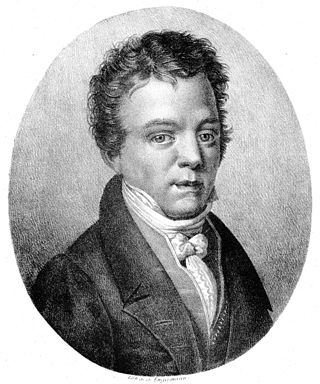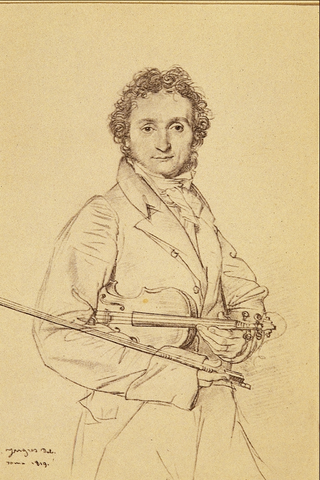| Symphony No. 1 | |
|---|---|
| by Louis Spohr | |
| Key | E flat major |
| Opus | 20 |
| Movements | four |
| Scoring | Orchestra |
The Symphony No. 1 in E flat major, Op. 20 by Louis Spohr was written and published in 1811 [1] and first performed in April of that year. [2]
The symphony is divided into four movements with the following tempo markings: [1] [3]
The symphony has been recorded by Howard Griffiths and the NDR Radiophilharmonie, as well as Howard Shelley with the Orchestra della Svizzera Italiana. A recording by Alfred Walter and the Budapest Symphony Orchestra on the Naxos label is also available. [1]
This is a list of music-related events in 1802.

Carl Wilhelm Eugen Stenhammar was a Swedish composer, conductor and pianist.

AntonJoseph Reicha (Rejcha) was a Czech-born, Bavarian-educated, later naturalized French composer and music theorist. A contemporary and lifelong friend of Beethoven, he is now best remembered for his substantial early contributions to the wind quintet literature and his role as teacher of pupils including Franz Liszt, Hector Berlioz and César Franck. He was also an accomplished theorist, and wrote several treatises on various aspects of composition. Some of his theoretical work dealt with experimental methods of composition, which he applied in a variety of works such as fugues and études for piano and string quartet.
Symphony No. 1 may refer to:

Jan Václav Hugo Voříšek was a Czech composer, pianist, and organist.
The two Serenades, Op. 11 and 16, represent early efforts by Johannes Brahms to write orchestral music. They both date from after the 1856 death of Robert Schumann when Brahms was residing in Detmold and had access to an orchestra.

The Symphony No. 1 in B♭ major, Op. 38, also known as the Spring Symphony, is the first completed symphonic work composed by Robert Schumann.

The Violin Concerto No. 1, Op. 6, was composed by Niccolò Paganini and dates from the mid-to-late 1810s. It was premiered in Naples, Italy on the 31st of March 1819.
Potpourri or Pot-Pourri is a kind of musical form structured as ABCDEF..., the same as medley or, sometimes, fantasia. It is often used in light, easy-going and popular types of music.

August Joseph Norbert Burgmüller was a distinguished German composer, renowned for his contributions during the nascent stages of the Romantic Era. His oeuvre, albeit cut tragically short due to his untimely drowning at the age of 26, continues to resonate in the annals of classical music.

The String Octet in E-flat major, Op. 20, MWV R 20, was written by the 16-year-old Felix Mendelssohn during the fall of 1825 and completed on October 15. Written for four violins, two violas, and two cellos, this work created a new chamber music genre. Conrad Wilson summarizes much of its reception ever since: "Its youthful verve, brilliance and perfection make it one of the miracles of nineteenth-century music." This was one of the first works of Mendelssohn to be very well received.

The Andante and Finale is a composition for piano and orchestra that was reworked by Sergei Taneyev from sketches by Pyotr Ilyich Tchaikovsky for the abandoned latter movements of his single-movement Piano Concerto No. 3 in E-flat, Op. 75.

The Piano Trio No. 2 in C minor, Op. 66, was written by Felix Mendelssohn in 1845 and published in February 1846. The work is scored for a standard piano trio consisting of violin, cello and piano. Mendelssohn dedicated the work to his close friend and violinist, Louis Spohr, who played through the piece with the composer at least once.
An organ concerto is an orchestral piece of music in which a pipe organ soloist is accompanied by an an orchestra, although some works exist with the name "concerto" which are for organ alone.
Ernst Dietrich Adolph Eichner [Ernesto Eichner] was a German bassoonist and composer.
Reinhold Glière wrote his Concerto for Harp and Orchestra in E-flat major, Op. 74, in 1938.
Joseph Touchemoulin was a French violinist and composer of the classical period who mainly worked in Bonn and Regensburg.
The Symphony No. 4 in F major, Op. 86 by Louis Spohr has the title "Die Weihe der Töne," meaning "The Consecration of Sound," and is a programmatic work based on the poem of the same name by Carl Pfeiffer. It was composed in 1832 and published in 1834.